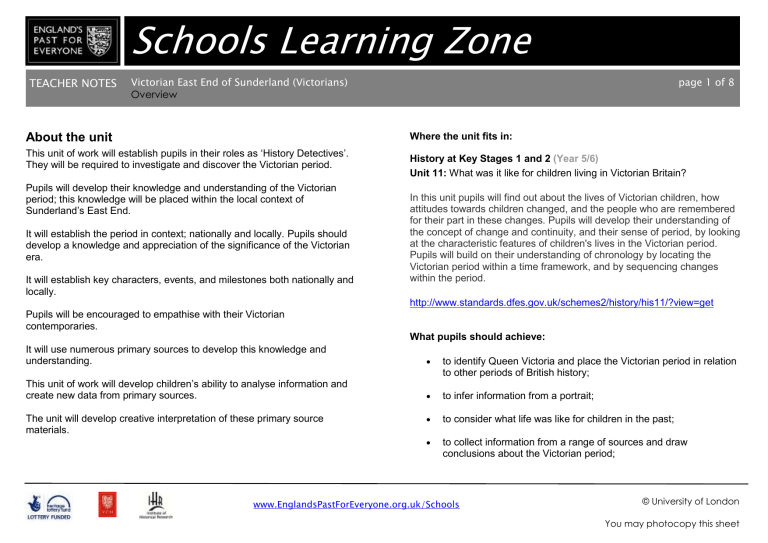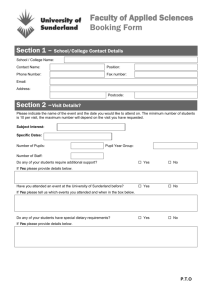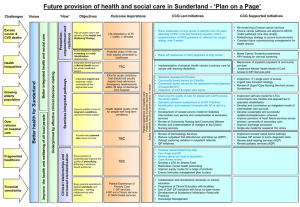Teacher Notes - Overview.doc

Schools Learning Zone
TEACHER NOTES Victorian East End of Sunderland (Victorians)
Overview
About the unit
This unit of work will establish pupils in their roles as ‘History Detectives’.
They will be required to investigate and discover the Victorian period.
Pupils will develop their knowledge and understanding of the Victorian period; this knowledge will be placed within the local context of
Sunderland’s East End.
It will establish the period in context; nationally and locally. Pupils should develop a knowledge and appreciation of the significance of the Victorian era.
It will establish key characters, events, and milestones both nationally and locally.
Pupils will be encouraged to empathise with their Victorian contemporaries.
It will use numerous primary sources to develop this knowledge and understanding.
This unit of work will develop children’s ability to analyse information and create new data from primary sources.
The unit will develop creative interpretation of these primary source materials. page 1 of 8
Where the unit fits in:
History at Key Stages 1 and 2 (Year 5/6)
Unit 11: What was it like for children living in Victorian Britain?
In this unit pupils will find out about the lives of Victorian children, how attitudes towards children changed, and the people who are remembered for their part in these changes. Pupils will develop their understanding of the concept of change and continuity, and their sense of period, by looking at the characteristic features of children's lives in the Victorian period.
Pupils will build on their understanding of chronology by locating the
Victorian period within a time framework, and by sequencing changes within the period. http://www.standards.dfes.gov.uk/schemes2/history/his11/?view=get
What pupils should achieve:
to identify Queen Victoria and place the Victorian period in relation to other periods of British history; to infer information from a portrait; to consider what life was like for children in the past; to collect information from a range of sources and draw conclusions about the Victorian period; www.EnglandsPastForEveryone.org.uk/Schools
© University of London
You may photocopy this sheet
TEACHER NOTES Victorian East End of Sunderland (Victorians)
Overview
to understand that ways of life differed greatly across Victorian society; to write a narrative using historical detail; to understand that there are many representations of the Victorian period;
to understand that the work of individuals can change aspects of society; to find out about important figures in Victorian times; to present their findings in different ways; to compare modern and Victorian schooling;
to communicate through drama their understanding of the nature of school life in Victorian times;
to consider how attitudes to children and childhood changed over time;
to recall information about the life of children in Victorian times;
to select appropriate material and present it in a way that shows their understanding of the period. page 2 of 8
This unit of work creates a number of opportunities for cross-curricular development:
Geography at Key Stages 1 and 2 (Year 3)
Unit 6: Investigating our local area.
Geography at key stages 1 and 2 (Year 1)
Unit 1: Around our school - the local area;
Section 7: Are there any changes taking place in our area?
Citizenship at key stages 1 and 2 (Year 1- 6)
Unit 1: Taking part - developing skills of communication and participation.
Citizenship at key stages 1 and 2 (Year 3 – 6)
Unit 7: Children's rights - human rights.
Design and technology at key stages 1 and 2 (Year 2)
Unit 2B: Puppets.
Design and technology at Key Stages 1 and 2 (Year 3)
Unit 3D: Photograph frames.
Design and technology at key stages 1 and 2 (Year 5)
Unit 5C: Moving toys.
ICT at Key Stages 1 and 2 (Year 1)
Unit 1E: Representing information graphically: pictograms.
Art and design at key stages 1 and 2 (Year 1/2)
Unit 1C: What is sculpture.
Aspects of Literacy and Mathematics can be developed from the primary sources. www.EnglandsPastForEveryone.org.uk/Schools
© University of London
You may photocopy this sheet
TEACHER NOTES Victorian East End of Sunderland (Victorians)
Overview
Suggested learning outcomes
Children will:
Be able to use historical sources such as photographs, burial records, maps, government reports and census ’ (census data) to
investigate the past.
Document their evidence photographically and creatively.
Communicate their knowledge and understanding through verbal responses.
Participate in group discussions to explore ‘then’ and ‘now’ differences.
Interpret information and data.
Analyse and present data from given sources.
Use information to develop further methods of inquiry.
Understand that documents can identify how people lived.
Contrast evidence from a variety of sources. www.EnglandsPastForEveryone.org.uk/Schools page 3 of 8
Background Information for Images
Rains Eye Plan, 1780s
This plan is a unique document; it is a hand drawn map/plan (not to scale) that depicts the East End, and parts of the West End, of Sunderland. It provides a visual representation of the town that shows aspects of ship building, housing, social conditions etc. It demonstrates the sharp increases in population and why Sunderland Parish was established as an independent parish.
You can see why the wealthy of this parish moved to the west end of town
(known often as the ‘best end’) as the population became densely over- crowded, and consequently many social ills were evident in the east end.
Population figures
1481 - 1,300
1681 - 3,900
1781 - 21,000
1881 - 140,000
© University of London
You may photocopy this sheet
TEACHER NOTES Victorian East End of Sunderland (Victorians)
Overview
Sunderland Parish Church, Holy Trinity
Holy Trinity Church is the original parish church of the township of
Sunderland. It was opened in 1719 to provide a place of worship for the people who lived in Sunderland. Until then, the nearest church had been
St Michael’s in the neighbouring village of Bishopwearmouth.
In the early 18th century, Sunderland was a busy riverside port offering harbour and opportunity to merchants, craftsmen, sailors and their families.
This church represented the culmination of a developing economy and community. The church illustrates the development of a new age of reason and enlightenment and a break away from what was seen as stayed old traditions; the functions and the design of the church demonstrate this. This was ‘new money’ – announcing that they had arrived and they too were important people in a developing town like
Sunderland.
The Church is now a redundant building. The Churches Conservation
Trust is responsible for its maintenance. Access and tours of the building can be arranged, telephone 0191 5654835. A brief detailed guide of this
Grade I listed building can be purchased. www.EnglandsPastForEveryone.org.uk/Schools page 4 of 8
Browne ’s House – Fitters Row
Edward Browne was a coal fitter and built this house in 1727. As a coal fitter he made a great deal of money – a coal fitter was the person who arranged selling coal between the coal mine owners and coal buyers. He built this house along with a row of cottages for his fitters – Fitters Row.
Brown’s House was renowned for its fine Georgian gardens, and many people would visit the site.
Browne lost his wealth very quickly, and the houses he had built became tenement housing and housed the poorer people of the parish. The area became known as The Hat Case and Fitters Row. It is interesting that this one site reflects some of the changes and developments of the east end, as it would later become the site of the first council flats to be built
( Harrison’s Buildings).
H arrison’s Buildings
In 1892 the area was declared unfit and was recommended for demolition and clearance (49 houses - 120 dwellings - 460 people).
Harrison’s Buildings, named after one of the councillors (Alderman
Harrison, Chair of the Sanitary Committee), Fitters Row became Rickaby
Street. The homes were completed in 1903.
Cholera in Sunderland
Sunderland, like many other cities and towns that experienced large increases in population, experienced many social ills. Health and sanitation conditions were dire. That is one of the reasons cholera entered
© University of London
You may photocopy this sheet
TEACHER NOTES Victorian East End of Sunderland (Victorians)
Overview
Sunderland in 1832 and swept over the rest of the country. The only place unaffected in Sunderland was The Barracks – Dr Clanny sealed the barracks and quarantined the place, and consequently no one died there.
Sunderland was lampooned locally and nationally for not quarantining the whole town, consequently cholera swept across the whole of the country.
One of the first victims of cholera was Jack Crawford. The famous illustration of Isabella Hazzard is included in the unit. She was also one of the first victims to suffer and die from this outbreak of disease.
Church Walk
The Workhouse, the Donnison School, Trafalgar Square Alms Houses, St
John ’s Vicarage, Holy Trinity Church were some of the key buildings on this lane. This was a very important and busy thoroughfare that provided direct access onto Coronation Street and led to the west end of town. It still has a number of those key sites which provide significant elements to any guided walk and discovery of the environment.
Trafalgar Alm Houses originally accommodated over 134 families when it was first built in 1840. It was a provision made for those who had been involved with the sea. They now accommodate 34 families.
The Workhouse, Church Walk
The Workhouse was on Church Walk opposite the Donnison School, it also had sites adjacent to the Donnison. Sunderland's first parish workhouse was built by public subscription in 1740. It was located in
Church Walk (later Trinity Place) near to the Parish Church. Trafalgar www.EnglandsPastForEveryone.org.uk/Schools page 5 of 8
Square now occupies the site of what was the workhouse garden. A labour yard was later added, and the building was extended in 1779. A parliamentary report of 1777 recorded a workhouse operating in
Sunderland for up to 90 inmates. At one time it was reputed to be home to over 600 inmates, although by May 1827 there were about 200 inmates.
Assembly Garth (Seaman’s Mission)
The Assembly Garth Almshouses, opposite the Parish Church, were established in 1750 by the Seaman's Fund for members of the town's seafaring community who were unable to care for themselves through misfortune, age or illness.
St John ’s Church 1796
St John’s Parish Church was built in 1769, chiefly at the expense of John
Thornhill; the site was at the head of Barrack Street, and was to take the overflow from the congregation of the Parish Church. During 1875 it became a parish in its own right. The church was demolished in 1972.
(See the document St John’s Parish Church: its works and limitations )
St Patrick’s Church
St Patrick’s Church was built in 1865 – located on the site of the houses opposite Holy Trinity Church (Trinity Place). It accommodated the growing
Catholic population in the community. By 1865 three very large churches were within less than a quarter of a mile radius, evidence of the thriving population.
© University of London
You may photocopy this sheet
TEACHER NOTES Victorian East End of Sunderland (Victorians)
Overview
Sunderland Boys Orphanage – 1861
Sunderland East End Orphanage Asylum was founded in 1853 for the children of seafarers. The building we associate with the orphanage was opened on 17 October 1861, under the patronage of the Bishop of
Durham, and the Stallingers of Sunderland, the latter being responsible for its upkeep. The building had a remarkable likeness to Queen Victoria’s
Osborne House, and it is noted that she asked to see the plans and made a donation of £100 towards its cost, which was estimated at £4,000. The name of the orphanage was changed in 1936 to ‘The Boy’s Orphanage
Sunderland’. In 1947 the building ceased to be an orphanage and became a community centre. The orphanage boys were eventually moved and relocated to Moorhill, Seaview Road, West Sunderland.
But for almost 84 years the orphanage was situated on the Town Moor and saw 800 boys pass through its doors. The boys were considered reliable citizens of the town, many of whom became heroes, both of the wars, and the sea.
“A great revenue arises from its exports, and its coal-trade is a capital nursery for seamen; and in time of war generally furnishes a very liberal quota for the manning his majesty's fleet. In the neighbourhood is constantly employed about twelve colliers, which produce 280,000 chaldrons of coals ” page 6 of 8
“ The High Street, which is the principal one, is about a mile long, from west to east, and from twenty to thirty yards broad ; the Low street is of a good length, very narrow, and runs parallel with the High Street. Besides these, there are several lanes between the two streets, and several streets which run south from the south side of the High Street. Sunderland is a borough, but sends no members to parliament.
”
The Universal British Directory , published in five volumes during the
1790s.
The Half Moon Inn
Early records point to the Half Moon estate being an area of clear deprivation that housed some of the poorest people of the parish; we assume the pub took its name from this – the land at that time belonging to
Lord Lambton.
Exchange Building
Exchange Building was built in 1814, to a design by John Stoke of
Newcastle upon Tyne, for a fee of £8,000 (raised by subscription of £50 shares) to be the administrative, commercial and cultural centre for the rapidly developing port area. A classical design built in stone, with a stucco façade and a clock turret built of iron and timber, it became the first Town
Hall for Sunderland and hosted many important social events, including a banquet hosted in 1827 by the Marquis of Londonderry in honour of the
Duke of Wellington. An outbreak of cholera in the east end of Sunderland in the 1830s marked the beginning of the decline of the building's prominence, as the focus of the city centre moved westwards. Towards the end of the 19th century the building became the Seamen's Mission, www.EnglandsPastForEveryone.org.uk/Schools
© University of London
You may photocopy this sheet
TEACHER NOTES Victorian East End of Sunderland (Victorians)
Overview and during the early 20th century the building was used by the Hebron.
Gradual decline in use during the post-war years saw the Grade II listed building slide into dereliction, threatening its survival.
James William Street
This street represented one of the first efforts by the Corporation to clear away some of the slums that existed in Sunderland and the East End. In
1872 the corporation cleared Bains Lane and Union Lane, and laid James
William Street. The street housed dwellings, a school and other public buildings. The school became known locally as ‘Jimmy Willies’ and is remembered with fond memories. The school has been demolished but some of the old housing still exists. www.EnglandsPastForEveryone.org.uk/Schools page 7 of 8
Teacher Pack contents
This pack of material contains the following documents:
Teacher Notes: Overview.
Lesson Plans: 1 – 5.
Activities: Additional Activity – Victorian Children.
Resources: St John’s Parish: it’s works and limitations ;
Victorian images for timeline activity;
Sunderland images for timeline activity;
Questions and Answers – Victorian timeline;
Queen Victoria bookmark;
Discovering the local area – List of street names;
Rain’s Eye Plan;
Burial Record;
Tally Sheet;
Images of Sunderland East End;
Victorian reports (extracts 1 – 3);
Images
© University of London
You may photocopy this sheet
TEACHER NOTES Victorian East End of Sunderland (Victorians)
Overview
Acknowledgements
This material was written by Janette Hilton, Living History North East
(based at the Old Donnison School, Sunderland).
The unit was sponsored by England’s Past for Everyone and draws on original research by Dr Gillian Cookson (for the EPE paperback
Sunderland: Building a City ).
The St John’s Parish: its work and limitations document and images are
© Sunderland Local Studies Centre. The Rains Eye Plan is © Sunderland
Antiquarian Society. Unless otherwise stated, all images are © Living
History North East.
Disclaimer
Although every effort is taken to ensure the accuracy of the information contained within the Schools Learning Zone , we cannot guarantee that the content will always be current, accurate or complete.
The England's Past for Everyone project reserves the right to remove, vary or amend any of the content of its website at any time and without prior notice.
The England's Past for Everyone project is not responsible for the content of external websites. References and links to any such sites shall not be taken as an endorsement by the University of London of opinions expressed or services provided at those sites.
The England's Past for Everyone project reserves the right to change these terms and conditions at any time at its sole discretion. www.EnglandsPastForEveryone.org.uk/Schools page 8 of 8
© University of London
You may photocopy this sheet







